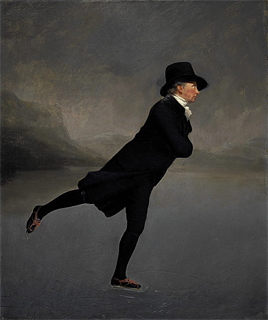This year’s picture for midwinter is Henry Raeburn’s small portrait of Reverend Dr Robert Walker Skating on Duddingston Loch. Painted some time in the mid-1790s, this lighthearted but exquisite portrait of a learned Scottish divine at his leisure is, deservedly, one of the most popular pictures in the National Gallery of Scotland in Edinburgh.
The extremely unusual setting and composition of Raeburn’s portrait may have been suggested to him by the sitter, who was a keen member of the Edinburgh Skating Society. He was, presumably, proud of the skills he had acquired in figure skating, described by his contemporary and fellow enthusiast Lord Cockburn as “the poetry of motion”. The elegant pose which he has struck for Raeburn would also have been recognised by experienced eighteenth-century skaters as “the travelling position”. This was a position designed to enable the skater to cover the maximum distance with the minimum of effort, involving the difficult act of maintaining balance while keeping both arms folded across the chest to reduce wind resistance. The artist has made the most of the contrast between the sternly ascetic black costume of the Scottish minister and the wild backdrop of Duddingston Loch on which he is shown skating – a stretch of water at the base of an outcrop of volcanic rock known as Arthur’s Seat, just east of Edinburgh. The pinkish grey crags and sky have been painted with great freedom, whereas the figure of Reverend Robert Walker himself is so tightly drawn and painted that he appears almost as a black silhouette against an icy, vaporous wilderness. Perhaps this was the artist’s way of suggesting that, for all his apparent probity and self-restraint, the minister was at heart something of a romantic – a man, at any rate, with a penchant for communing...


